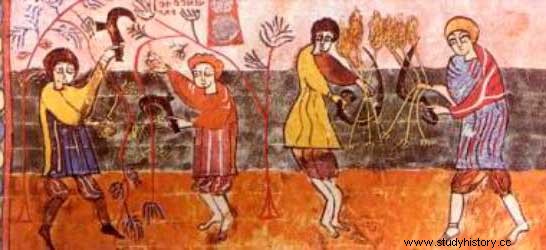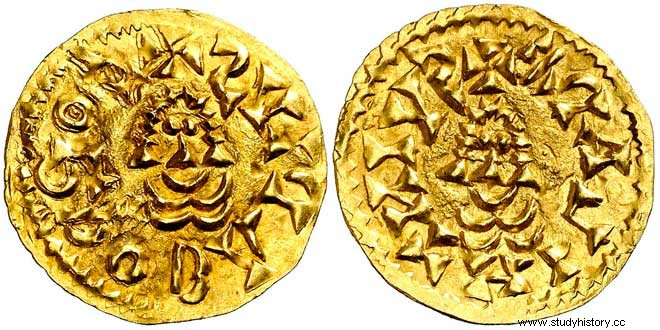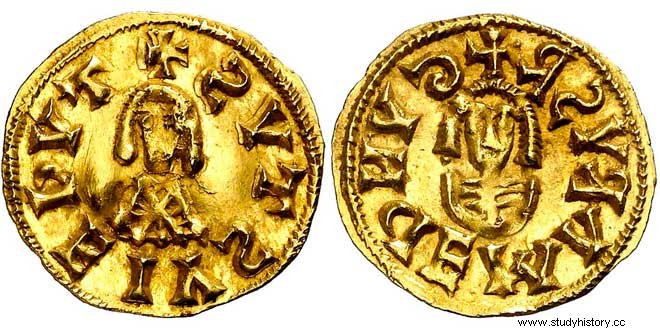The main source of wealth in the Visigothic economy was agriculture, as befits a society mostly tied to the land . In this activity, as in others, they are heirs and continuators of the last times of the Low Roman Empire, even increasing its decadence. The forms of exploitation of the land continue to be centered on the village, with the division of the land into two parts:the one that the owner cultivates directly through serfs, the dominicatum , and the rest, which he distributes in plots among the settlers. Agricultural technology is also similar, with the use of the common plow, the use of animals for plowing and threshing, little fertilizer and only organic, and long fallow periods of even ten years.
Agriculture and livestock
Roman irrigation was maintained, with canals and ditches, so there were sectors with artificial irrigation, what we call orchard. There are laws of Recesvinto penalizing the theft of water, with a fine and subsequent return of the irrigation shift, as well as diversion "because it took power away from the mills." Production did not vary substantially either, hardly any new species were introduced. Cereals were mainly cultivated, many vines even in the highlands, and olive trees, especially in Baetica. Cereal was required by food customs; wine was the usual nutritional complement, but it was also necessary everywhere to celebrate Mass, and as for the olive tree, Saint Isidore distinguishes three kinds of oil:the common, extracted from black olives, the green, from green olives, without mature and the Hispanic, which was the best, from white olives. The oil industry was one of the most important in Visigoth Hispania . There were fruit and vegetable crops in the orchards, even protected by law, as well as some trees (apple, olive) were protected and the clearing of mountains and meadows was encouraged, granting the cultivator a third of the land put into cultivation.

Worked Lands
The small free properties were cultivated by their owners, the privati , but with the passage of time, already in the 7th century, production focused on the large property, conceived as a unit, the villa, in which not only agricultural products were obtained but also livestock activity was centralized and essential crafts were carried out to meet the needs generated within the farm itself. The latifundia were of capital importance from the economic, social and political point of view, they were in the power of magnates whose base of wealth and power they constituted, and they were cultivated by serfs, semi-free men, freedmen and entrusted men. Ecclesiastical manors, also abundant, were cultivated by servants of the Church, by freedmen sub obsequium or by settlers who paid the owner 10% of the product they produced. The patrimony of the Crown, made up of some three thousand villas or large properties, were cultivated by the numerous tax serfs , attached to the earth.
Livestock
Livestock farming, especially wool, as a complement to agriculture occurred in all the towns . However, there were regions with a purely livestock economy (northwest Galicia) of transhumant herds that constituted the main livelihood of the monastic communities in this area, according to the Life of Saint Fructuoso. Some blackboards show the payment of tolls for transhumance and the nomenclature of the cattle:anniculi (one year), sesquanas (year and a half) and trimos (three years). Pigs were also bred:Valerio de Bierzo, in the last decades of the 7th century, wrote that pig keepers abounded among the rustic of the servile families belonging to the great landowners of the Leon area. Horse breeding was important, especially in Baetica.

Industry and commerce
Mining declined a lot compared to the time of the Lower Empire due to the depletion of the mines, but the extractive industry of silver, lead, copper and tin, as well as gold from auriferous sands, still survived to a certain extent. As for the industry, among the few innovations of the Visigoths is metallurgy with beautiful achievements in the cabochon of semi-precious stones in gold and silver work. There was a textile and tanning industry with skin and leather processing.
The construction
Construction was a flourishing industry, especially in the 7th century, despite the fact that there are not many preserved monuments, —artistic pieces from disappeared constructions are preserved—. The explanation that has been given for this phenomenon is that those that remain are in places far from the penetration routes of the Muslims, while the buildings of the cities and more populated areas, especially the religious ones, were destroyed or transformed by the conquerors. Others are related to this industry, such as stone carving for jambs and capitals and ceramics, whose main focus is located in the Guadalquivir valley.
Domestic Trade
Internal trade was very scarce and foreign trade weakened enormously, although it did not disappear completely (oil is exported...). The rarefaction of domestic trade is due to the fact that there is little to sell and there is a lack of demand, as a result of a closed and self-sufficient economy. However, there were markets, the fountains signify with the name of conventus mercantium the meetings of merchants to celebrate the fair that used to be held in the main square of many cities.
Foreign Trade
The little foreign trade was in the hands of overseas foreigners, although there were also Hispanics who practiced it. The merchants engaged in this trade were governed by a special law, the "Rhodium" and had special judges, the telonarii , as well as own contracting markets, called cataplus , in the busiest sea and river ports.
The coin
The circulation of coins was scarce since the lay and ecclesiastical upper classes invested their profits in gold and silver treasures, without the slightest investment spirit, so that in rural areas taxes were often paid in kind. But this does not mean that the Hispanic-Visigothic economy was not monetary, since everything is valued in money (fines, payments...). The practically monometallic monetary system of the Visigoths was based on Constantine's gold salary (1/72 of a Roman pound) and on Byzantine currency, which they first used and then imitated . But it will not be until the reign of Leovigild when the minting is made in the name of the king, and not the emperor of the East, responding to the political propaganda that the concept of the Visigothic State required. Thus, its own currency, minted in Hispania and already independent of the Empire, appears with Leovigild (573-586), who puts his name instead of the Byzantine emperor , although it retains for a time on the obverse the imperial theme of a walking Victory, to the right of the bust of the king and surrounding the entire legend Liuvigildi regis conob preceded by a small cross. On the reverse, the cross will curdle over time, surrounded by the legend with the name of the mint. In any case, the types differ in terms of figures, legends, diameter and weight. The salary was never minted, which became a currency of account like the pound; tremises were minted or trientes de oro (a third of the salary), which became the Visigothic national currency. The fractional currency, the siliquae, was not minted either. , serving as such the existing Roman silver and bronze pieces, which continued to circulate.

The equivalence was as follows:
1 pound =72 salaries =216 tremises =1,728 siliqua
1 salary =3 tremises =24 siliqua
1 tremis =8 siliqua
Monetary minting was reserved for the king, as a "royalty" or exclusive right, although there are reports of private minting, perhaps secessionist kings whose aspirations did not come to fruition. There were many mints, about 80, located next to the gold mines; there were also mobile mints, due to the sudden need to mint "in situ". The trients of the kings from Leovigildo to Wamba had good law and correct weight; from Egica (687-702) they degenerated, so that at the beginning of the 8th century they were practically made of silver. As for the official weight, that of the Leovigildo tremís was 1.45 grams. and that of Witiza 1.25. It was always forbidden to cut or falsify the coins.
